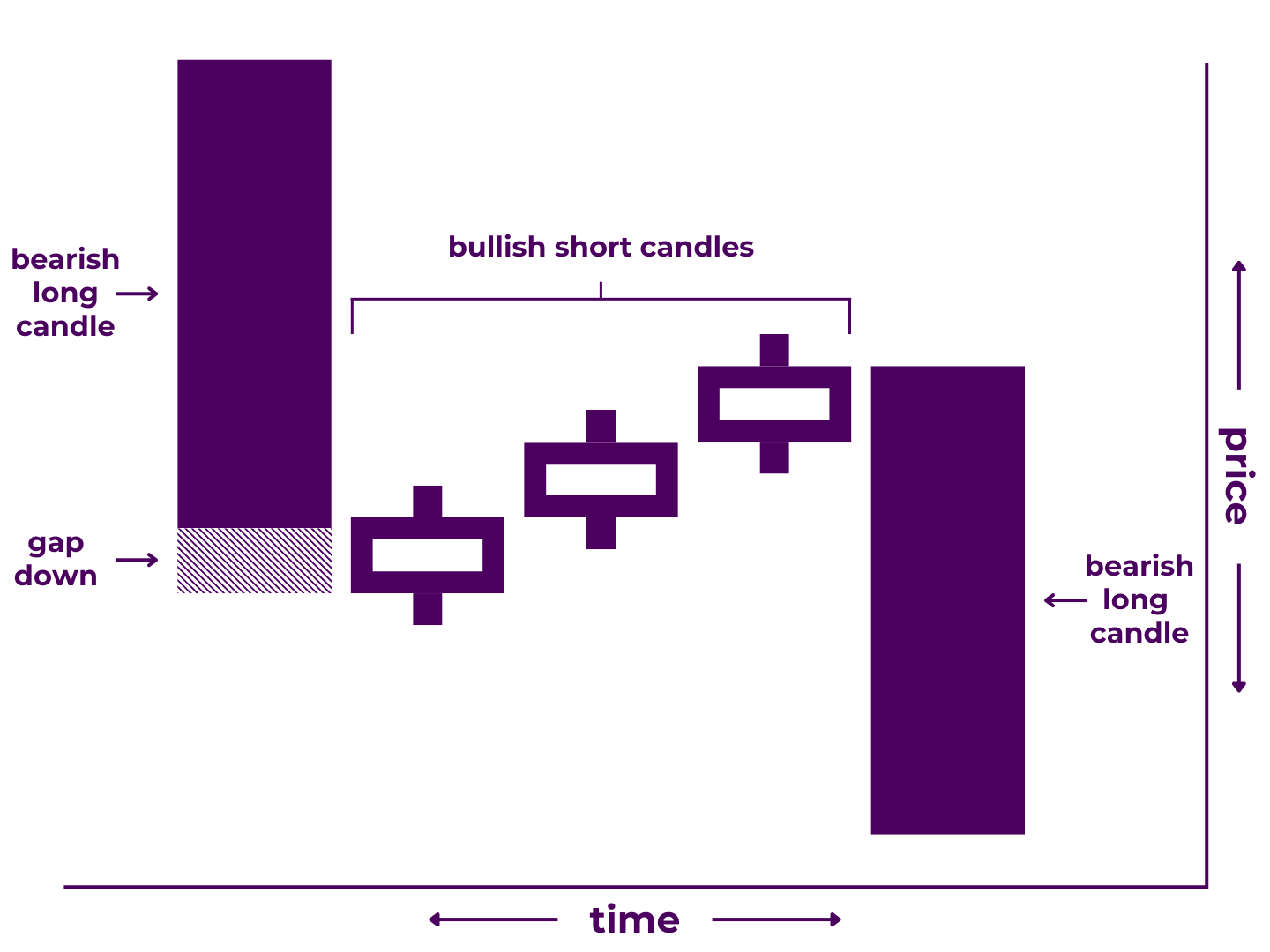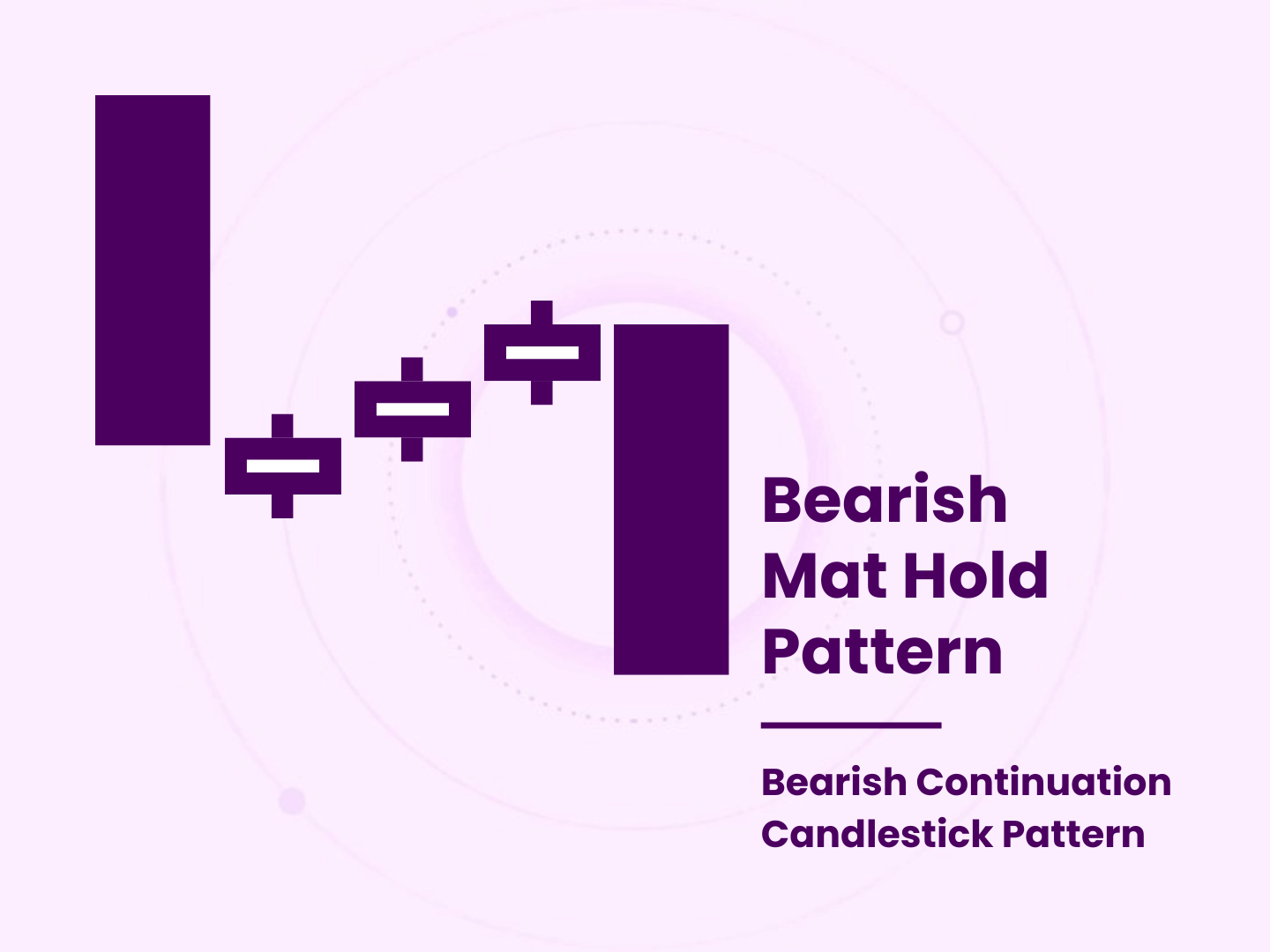Bearish mat hold patterns are fairly rare but give a clear signal.
Since candlesticks are the basic building block of most technical analysis, the ability to recognize different candlestick patterns is a crucial trading skill.
In this Guide to Bearish Mat Hold Patterns, we’ll explain:
First though, let’s start with a definition.
What Is a Bearish Mat Hold Pattern?
A bearish mat hold pattern is a 5-candlestick formation that may signal a bearish continuation. It may appear in a downtrend and is made up of a large bearish candlestick followed by a gap down and three smaller bullish (or neutral) candles that fill the gap but never close above the first candle’s open, then another large bearish candle that closes below all previous candles.

It is the bearish version of the mat hold pattern, making it the opposite of the bullish mat hold. It is also very similar to the falling three methods. Both include three small bullish candles sandwiched between two large bearish candles. These three smaller candles represent a short period of consolidation before the downtrend continues.
Of course, no candlestick pattern guarantees a particular outcome. Instead, they offer clues as to what is going on in the market.
So the question is, what does a mat hold really tell you?
What Bearish Mat Hold Patterns Mean
Like many candlestick patterns, the name itself doesn’t reveal much.
And unlike some, English speakers do not use the Japanese name for it. We could not find any information about where the name comes from. We thought it might be named after a sumo technique, like the belt hold candlestick but found nothing.
(If you know the true meaning, please leave it in the comments below).
In trading terms:
- During the first period, price continued the pre-existing downtrend.
- The second period opened with a gap down that was filled over the course of the next three periods as price moved back up but never closed higher than the first period’s open.
- During the fifth period, price resumed downward movement and closed lower than any of the preceding four periods.
This sets the stage for bearish continuation, as selling pressure doesn’t look like it wants to let up anytime soon.
How To Recognize Bearish Mat Hold Candlestick Patterns
Traders are attracted to patterns partly because they are easy to spot.
However, it’s also easy to see things on the charts that aren’t truly there (or anticipate events that never come to fruition). That’s one of the reasons why waiting for confirmation is so important.
Technically, a bearish mat hold pattern must:
- Appear during a downtrend
- Begin with a bearish long candle
- Have a gap down after the first candle that gets filled over the course of the next three candles
- Have three consecutive bullish (or neutral) short candlesticks after the first candlestick that never close above the open of the first candlestick
- End with another bearish long candlestick that closes below the body and wicks of all preceding candlesticks in the pattern
In practicality though, many traders will make various exceptions.
- The first candle doesn’t necessarily have to be a long candle, as long as its body is longer than candles two, three, and four.
- The middle three candles don’t necessarily have to be short candles, as long as all of them are shorter than candle one.
- One or more of the middle candles can be bearish, as long as the gap gets filled before the fifth candle begins.
- There can be more than three candles between the first and last candles, as long as the gap gets filled and none of the middle candles close outside the body of the first.
- The gap can go, especially in markets where gaps are less common, like cryptocurrency.
- The final candle doesn’t necessarily have to close below all of the wicks of the prior candles, as long it closes below their bodies.
Depending on who you ask, any of these standards may be more or less important. Moreover, some of these variations may be more properly classified as other continuation candlestick patterns, such as the falling three methods.
Remember, identifying the continuation itself is more important than labeling the formation. That’s not to say these standards are completely unimportant (as we’ll touch on shortly). It’s just to say that the implications are more important than the criteria.
In other words, you need to put it into context.
Where Bearish Mat Holds Fit in the Chart Narrative
The markets are often characterized as a battle between the bulls and the bears.
Bearish mat hold patterns show that the bears attempted to press their advantage on candle one (and between candles one and two), stalled for the next three candles, before finally regaining control and pressing trend further by the end of the fifth candle.
On the chart, it looks like a one-sided beatdown.
It might happen like this on a daily time frame:
The first day was a lopsided victory for the bears, continuing the momentum of the preceding weeks. That momentum bled over into after market hours, resulting in a gap down open on the second day. From that point, the bulls scored a bit of reprieve from days two through four. However, they weren’t able to make any meaningful gains. So once the fifth day rolled around, sellers came back in with renewed vigor, pushing price down to yet another new local low.
From here, it appears to be a bear’s world while the bulls just live in it.
In the short-term, it amounts to a near-knockout blow.
The question traders need to ask themselves is, “Can the bulls come up with an answer or is the market destined for an even larger move lower?”
To answer that question, you’ll need more than just an understanding of Japanese candlesticks and candlestick patterns. You’ll want to analyze both within the context of greater chart patterns as well as trend and price levels. You’ll also want to make use of your own chart markup and indicators.
Analyze the history of your preferred asset(s) with respect to mat hold patterns and apply it to your own trading style.
Now, you can test (and/or stretch) the criteria we mentioned above to find the most tradeable opportunities. For example, you may find that bearish mat holds in which the middle three candles stay below the 50% mark of the first candle play out more reliably than those where they don’t. Or, you may find something else entirely.
Here is where the story in the charts begins to come into focus.
This is what we call technical analysis.
How To Trade Bearish Mat Hold Patterns
Bearish continuation points are great places to add to your short position or move your stop loss down.
Bearish mat hold patterns serve as easy-to-spot signs of potential bearish continuation that may serve as a launch point for the next big leg down.
Generally, you can put more weight into multi-stick patterns than single candles. They give you more information over a longer amount of time. Still, it is considered unwise to trade based on candlestick patterns alone. They rarely have extremely high hit rates by themselves.
You need additional points of confluence to shift the probabilities in your favor.
Some of the more important ones include:
- Volume – For bearish continuation, you typically want to see low trading volume on bullish moves. That means low volume on the middle candles of a bearish mat hold may be a good omen.
- Price Formations – Bearish continuation patterns like the bearish mat hold tend to perform better when there is thin (or non-existent) support in their way. The further below and weaker the better.
- Matching Momentum – Oscillating indicators like the RSI or stochastics are commonly used to identify continuation by analyzing slope, percentile, and/or divergence.
The fewer such factors corroborating the continuation, the less confident you can be about it.
It would be difficult to form a comprehensive trading strategy around mat hold patterns (whether bullish or bearish). There simply isn’t enough there to develop a strong edge. Even with a great understanding of trading math, orders, psychology, risk management, options, and automation, you’d still have a hard time.
You’re much better off building your strategy around other tools then using continuation patterns as an additional point of confirmation.
Patterns like the mat hold are much better idea givers than trade makers.
Other Candlestick Pattern Types
The bearish mat hold is but one of many candlestick patterns.
You’d be wise to get familiar with all of the other ones too.
- Abandoned Baby – Bearish | Bullish
- Breakaway – Bearish | Bullish
- Counterattack Lines – Bearish | Bullish
- Doji Star – Evening | Morning
- Engulfing – Bearish | Bullish
- Gap Three Methods – Upside | Downside
- Harami – Bearish | Bullish
- Harami Cross – Bearish | Bullish
- In Neck – Bearish | Bullish
- Kicking – Down | Up
- Ladder – Top | Bottom
- Last Engulfing – Bottom | Top
- Matching – High | Low
- Meeting Lines – Bearish | Bullish
- On Neck – Bearish | Bullish
- Separating Lines – Bearish | Bullish
- Star – Evening | Morning
- Stomach – Below | Above
- Tasuki Gap – Downside | Upside
- Three Inside – Down | Up
- Three Methods – Falling | Rising
- Three Outside – Down | Up
- Three-Line Strike – Bullish | Bearish
- Tri-Star – Bearish | Bullish
- Tweezer – Top | Bottom
- Window – Falling | Rising
Sure, there are quite a few of them. But don’t let that intimidate you.
It’s unnecessary to memorize all the names and criteria for every pattern. What’s more important is to learn the principles of price action and technical analysis.
In fact, you’re free to forget all of the names and specifications as long as you can look at a group of candlesticks and understand what they are trying to tell you.
Takeaways
To review:
Bearish mat holds are a type of candlestick pattern that signals a potential bearish continuation. While not a guarantee, their appearance may indicate that market conditions are going to remain the same. Thus, they can help you find winning trades.
Of course, there are other candlestick patterns that you should learn about. And even so, the ability to recognize patterns is not enough to trade successfully on its own.
Nonetheless, you’ve now added one more tool to your toolkit.
Have questions or more information to add? Contribute to the conversation in the comments below! Or, if you know someone who could benefit from this post, share it with them. You can also check out our Candlestick Patterns Guide to improve your candlestick analysis skills.


0 Comments